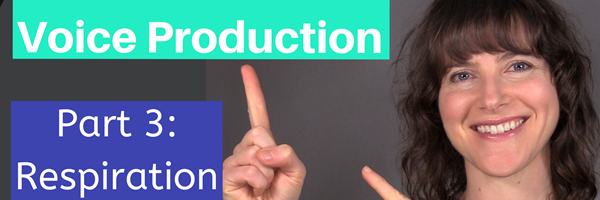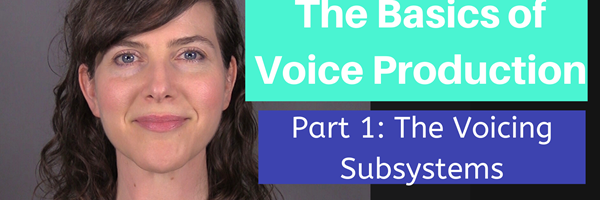*Click to watch Part 1: The Vocal Subsystems
Most of us can agree on the importance of warming up our bodies before we start exercising. Without a proper warm-up, our muscles may be stiff and be more susceptible to injury. Stiff muscles equals more risk of pulling and straining, which leads to more chances of injury. Warmer muscles are more flexible and pliable, which helps our bodies to absorb impact and move to its full range of motion.
Our voices are also controlled by muscles, most of which you can’t see, but these muscles also need to be warmed up properly if we want them to function at their best.
Now, I want you to consider yourself as a professional voice user - you are someone who relies on their voice to communicate and be successful. Your voice is your instrument, and you need to keep it in good condition just like you would treat your body if you were a professional athlete.
These vocal warm-ups are a great way to keep the voice and speech muscles flexible and pliable, so that they can produce a voice that is strong and clear. I recommend completing these exercises every day, and especially before you are going to be speaking for a long period of time.
The exercises go through each body system of the voice and speech. If you’d like to know more details about how voice and speech are produced, please watch the first video in this series, the Basics of Voice Production.
1) Upper Body and Face Stretch
It’s important to release any tension you have in your face, neck, shoulders, and back. Tension in these muscle groups may also lead to tension in the deeper muscles of your throat, face, and torso.
-
Stand up tall. Roll the shoulders backwards in small circles 5 times. Now switch directions and roll the shoulders forwards in small circles 5 times.
-
Gently drop the head down and roll the head side to side 5 times.
-
Smile wide, stretching the face and cheeks outward. Then bring the lips together in an “o” shape (like you’re saying the vowel “oooo”). Alternate the smile and “o” shape 5 times.
-
Open the mouth wide, like you’re saying “ahh”, to stretch out the lips and jaw 5 times.
-
Get the lips moving by completing a lip trill with just airflow (no voicing). Do for 3 breaths.
-
Now get the tongue moving by completing a tongue trill with just airflow (no voicing). Do 3 breaths.
-
To release any tension you may have in the face and neck muscles, massage the jaw muscle in front of the ear, moving your fingers in small circles. Now massage the muscles under the chin with your thumbs. Allow the jaw to drop open.
-
You can continue to massage the neck, head, and shoulders, depending on where you feel tension.
2) Respiratory System
The breath is the power source of voicing - without good airflow, you won’t have a good voice. Try the following exercises to warm up the muscles of respiration.These exercises work best if you are standing in front of a mirror.
-
Stand up tall. Roll the shoulders up, back, and then down, and lift the chest upward. Imagine there are strings pulling from the top of the head and the chest, lifting up towards the ceiling. The chin should be neutral with the ground.
-
Let the stomach relax and take a deep breath in through the nose, concentrating on filling up the lungs from the bottom of the lungs to the top. Feel how the stomach drops low with the breath.
-
Watch the shoulders as you breathe in - the shoulders should not move.
-
You should see the movement in the rib cage and stomach - the rib cage should go out and up, and the stomach should pop out.
-
Inhale through the nose, and exhale through the mouth on the “s” sound: “ssssssssssss”. Remember to keep the stomach relaxed. Do this 3 times.
-
Now when you exhale, increase the volume of the airflow from soft to loud: “sssssSSSSSSSSSS”. Use the stomach muscles to control the airflow. Do this 3 times.
-
Now go from soft to loud to soft on one exhalation: “sssssSSSSSSssssss”. You should feel the stomach muscles contracting as you do this. Do this 3 times.
3) Resonatory System: Humming
You want a voice that sounds effortless and easy - not one that is strained or harsh.
These exercises will help the voice resonate within the open spaces in your mouth and nose, which will give the voice a smooth and relaxed quality.
-
Stand up tall. Take a breath in and exhale on a hum at a comfortable pitch: “hmmmmmmmm”.
-
Place your fingers along the sides of the nose and lips while you’re humming - you should feel a buzzy vibration.
-
Feel the flow of warm air coming out of the nose. Now to increase the amount of airflow, you should focus the airflow towards the roof of the mouth. Allow the air to flow from the lungs, through the throat, and out of the nose as you hum.
-
The hum should be easy and effortless, and it may even feel soothing to the vocal cords.
-
If you have a difficult time starting the hum, pretend you are answering a question in agreement and say, “Mmm-hmmm”. Now hold out the “hmmm” portion.
-
Once you feel a nice, buzzy sensation along the nose and lips, you can glide up and down a scale on the hum, going from low to high and high to low.
-
Do 5 times.
-
If you feel any tension in the throat as you hum, try this: Move your head in a figure 8 pattern as you hum up and down a scale. This may help to distract your brain from its normal patterns of tension, and allow the muscles of the resonatory system to fully relax.
-
Now to open up the voice: Hum at a very high pitch, imagining that the voice is coming out from the top of the head to the ceiling. Feel the buzz of the voice into the upper part of the nose and forehead.
-
Now start at a high pitch, and hum all the way down through the full pitch range of the voice.
-
To make sure there isn’t any tension in the jaw muscles, move the jaw as you hum, like you’re pretending to chew gum.
-
Remember to feel a buzz along the lips and front of the mouth as you hum.
4) Phonatory System: Sustained Pitch
You’ve warmed up the muscles of the torso, stomach, and inner throat, and you’ve established good airflow. Now let’s continue to warm up the vocal cords and inner throat muscles.
-
Stand up tall. Take a deep breath in, and yawn when you exhale. It should be an easy, light yawn, and the throat should feel open and relaxed.
-
Now say the vowel “ah” on a comfortable pitch and sustain this note. Stop before you run out of air. Do 3 times.
-
Switch the vowel sound to “ooo” on a comfortable pitch (feel free to change the pitch) and sustain this note, but stop before you run out of air. Do 3 times.
-
Switch the vowel sound to “eee” on a comfortable pitch (feel free to change the pitch), and stop before you run out of air. Do 3 times.
-
Now say all three vowel sounds in one breath at the same comfortable pitch: “ahh - ooo - eee - ahh - ooo - eee”. Stop before you run out of air.
5) Phonatory System: Pitch Glide
Once your vocal cords feel warmed up, let’s stretch out the inner throat muscles with pitch glides.
-
Stand up tall. Say the vowel “oo”, starting at a comfortable pitch. Glide up a scale to the highest pitch that feels comfortable (no straining!). Hold the high pitch for as long as you can, but stop before you run out of air.
-
Make sure you keep the throat open as you say the “oo” sound. Relax the throat muscles and sustain your voice with good airflow. Don’t allow your voice to drop into a fry quality.
-
Now say the vowel “oo”, starting at your highest comfortable pitch and glide down a scale to your lowest comfortable pitch (no straining!). Hold the low pitch for as long as you can, but stop before you run out of air.
-
Again, make sure you keep the throat open as you say “oo” and use good airflow to power the voice. Don’t allow the voice to drop into a fry quality, especially as you go to the lower tones.
-
Now glide up and down the scale, starting at your lowest pitch and up to your highest pitch and back down, in one breath. Make sure you don’t strain at the low or high ends of your range.
-
You can also use the vowels “ah” and “eee” to complete this exercise.
6) Articulatory System: Face, Lips, and Tongue
Now that you’ve warmed up the respiratory muscles, the phonatory muscles, and the resonance muscles, it’s time to warm up the last group of muscles involved in speaking: your face, lips, and tongue.
-
Stand up tall. Stretch out your facial muscles as you move your lips and cheeks in small circles.
-
Take a breath in and say the following: “May...Me..My...Mow...Moo”. Try to connect the words together by saying them in one breath, and stretch out the “mmm” sounds. “Mmmmaaayyymmmmmeeeeemmmmmyyyyyymmmmmoooowwwwmmmoooo”.
-
Exaggerate your facial movements as you articulate the words - open your mouth wide as you say each sound.
-
Now say the following words in the same pattern as above:
-
“Lay...Lee...Lie...Low...Lou”
-
“Bay...Be...By...Bow...Boo”
-
“Tay...Tea...Tie...Toe...Too”
-
“Kay...Key...Kye...Koe...Koo”
-
Now to warm up the front of the tongue: Say “duh-duh-duh-duh” as fast as you can, moving up and down your pitch range. Don’t allow your jaw to help out! The movement should be with the tongue only.
-
Now to warm up the middle of the tongue: Say “yo - yah, yo-yah, yo-yah” as you change the pitch from high to low.
-
Now to warm up the back of the tongue: Open your jaw the width of two fingers. Keep your jaw open as you say “guh-guh-guh-guh” as you move up and down your pitch range. Place your hand on your chin to make sure that the jaw is not moving - only the tongue should make this sound.
-
Now challenge your articulators with the following tongue twisters (try going slowly at first, then try to say them each 3x fast):
-
“Red leather, yellow leather”
-
“Unique New York”
-
“She sells seashells by the seashore”
-
“Do daily deeds diligently”
Thanks so much for watching! In the next part of the series, I’ll go into more depth about each subsystem, starting with exercises to improve respiration and breath support. Stay tuned! And I'd love to hear from you - contact me to learn how we can work together to perfect your American English pronunciation!



